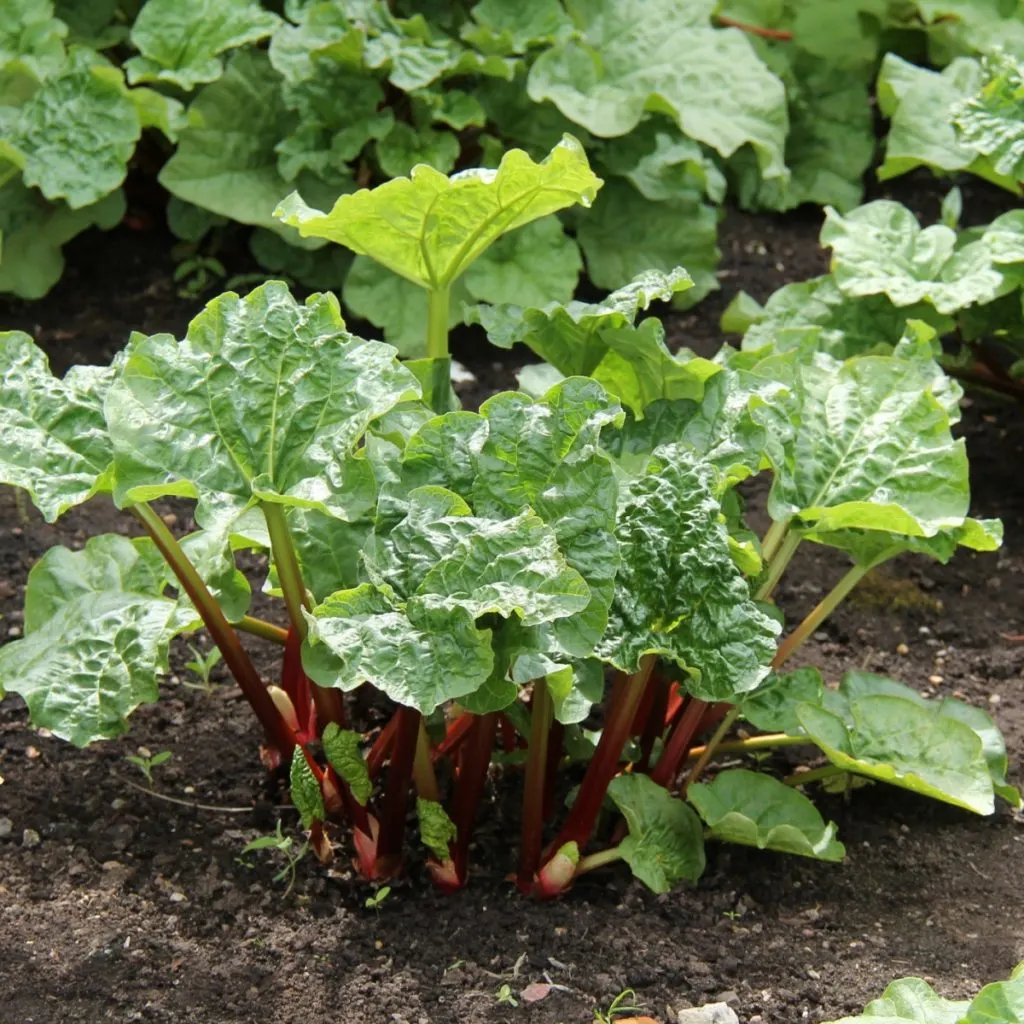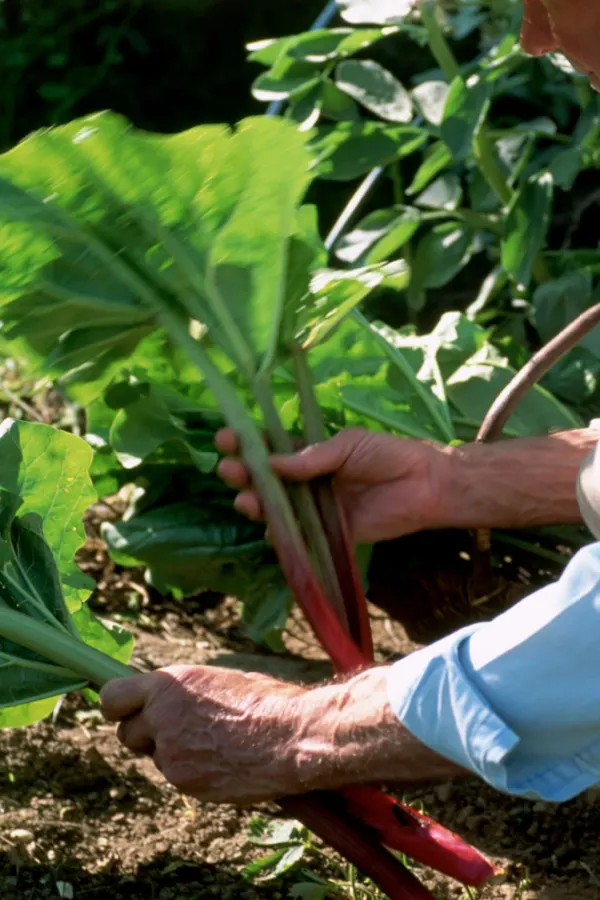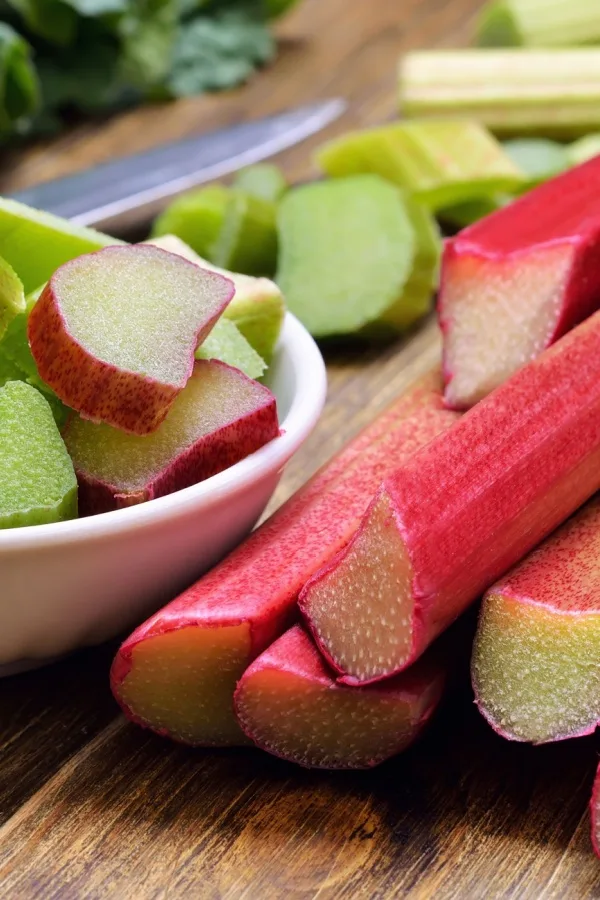Always wanted to plant and grow your own rhubarb – but worry about how to harvest it and grow it safely? Rhubarb is certainly a unique vegetable to grow – especially if you love making delicious tart sauces, jams, pies and crumbles early in the growing season!
If there is one thing that always stands out from my own childhood, it was my Uncle Eddie bringing my mom fresh rhubarb in the early spring. As soon as we saw it on the counter – we knew fresh pies were coming our way. To this day – whenever I see rhubarb stalks, it brings those memories flooding right back!
As interesting as the plant and flavor profile of rhubarb is, it’s also one of the most misunderstood when it comes to growing, harvesting and using it. With rhubarb, only the long red or green colored stalks are edible. And do they ever they feature an amazingly sour bite. But its leaves are another story!
Each stalk of rhubarb produces massive leaves at the end of its stalks. These leaves are not edible and actually contain large amounts of oxalic acid, which is toxic when consumed. The good news is that the leaves can safely be composted in your compost pile or disposed of without worry.
As soon as they break down, the oxalic acid breaks down completely and disappears. As for pets, it is toxic to them as well, but due to the plants sour nature, most animals will not touch it, and if they do, they will not consume it.
About Rhubarb – How To Plant, Grow & Safely Harvest Rhubarb
For those that love rhubarb, it is that extreme tartness of the stalks that makes them perfect for being sweetened and cooked into sauces and other delicious baked goods.
What makes this perennial even more special is that it’s one of the first plants of all to produce an edible harvest. In fact, just as the ground starts to thaw out and the snow melts in early spring, new rhubarb leaves begin to emerge from the soil – and the harvest isn’t far behind!
You can grow rhubarb by seed, or, as is most often the case, from plants or crowns. It’s also very easy to plant and grow rhubarb from divisions from an existing plant as well.
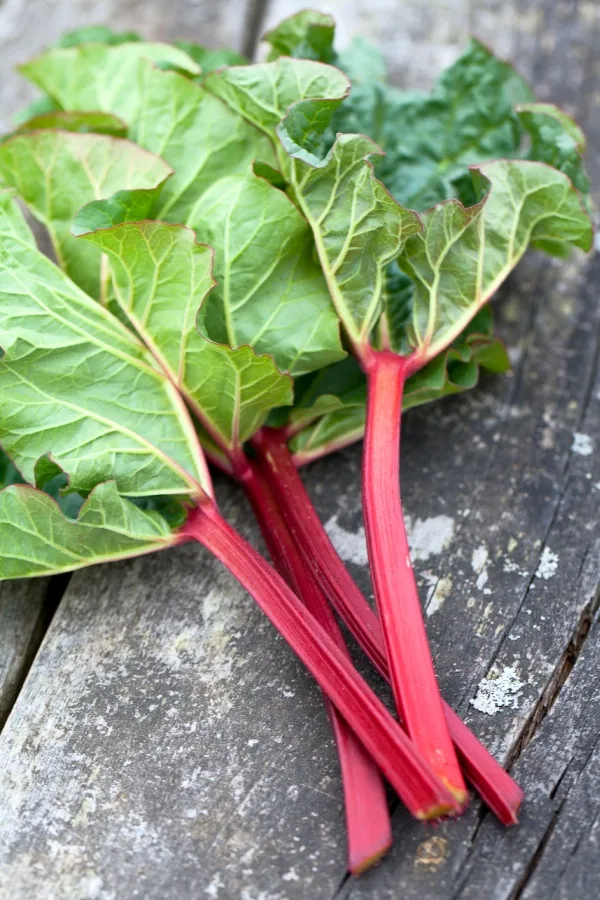
Each rhubarb plant produces multiple long stalks that can range from dark green to a vibrant red. The color does not affect or change the flavor of the rhubarb in the least, but instead is simply a color variant that depends on the type of rhubarb plant you grow.
While rhubarb is often treated like a fruit when it comes to baking and cooking, it’s technically a vegetable. Each rhubarb plant can grow to a massive size, spreading out over 4 to 6 feet wide and 4 feet tall.
One thing is for sure, since they live for 10 years or more, they need plenty of dedicated space in your garden or raised bed!
How To Plant, Grow & Harvest Rhubarb Safely!
The Art Of Planting & Growing Rhubarb
Rhubarb requires a period of chill hours of below 40º Fahrenheit in order to grow and produce stalks the following spring. This makes it an ideal perennial crop for the cooler growing zones of 3 through 8.
Although you can plant from seed, it can take a long time to establish and produce an edible harvest. For this reason, most choose to start by planting crowns or divisions. With this type of planting, you can harvest a bit of rhubarb as soon as the following year. Affiliate Plant Link: Victoria Rhubarb Crown – Perennial Rhubarb Crown

What’s most important when planting rhubarb is selecting the right location. For starters, rhubarb needs sunlight. Select a dedicated spot in your garden that receives full sun for at least 6 to 8 hours a day. A bit of afternoon shade is fine, but it’s vital that it gets enough sunlight to produce good stalks.
Keep in mind the mature plant size when planting. Rhubarb can live for ten or more years and will need plenty of space to expand. Around the edge of a garden or in a dedicated raised bed is usually a great spot for these hardy plants.
Planting – How To Plant, Grow & Safely Harvest Rhubarb
You can plant rhubarb as soon as the soil is workable in early spring. You can also plant rhubarb in late fall once plants have reached dormancy. When planting seedlings, divisions or plants that you purchased from local nurseries, you will want to plant them as deep as their current container or soil line
When planting crowns or bare root plants, it’s best to keep the top of the crown about two inches below the soil line. Whichever type you plant, begin by loosening the soil to a few inches below the depth you will be planting.
Even though you won’t plant the rhubarb this deep, this helps the roots grow and expand easily. Mix in plenty of compost to add in loads of organic matter and help improve drainage prior to planting. Water in well to help set the roots. This little bit of prep will go a long way to rhubarb growing success!
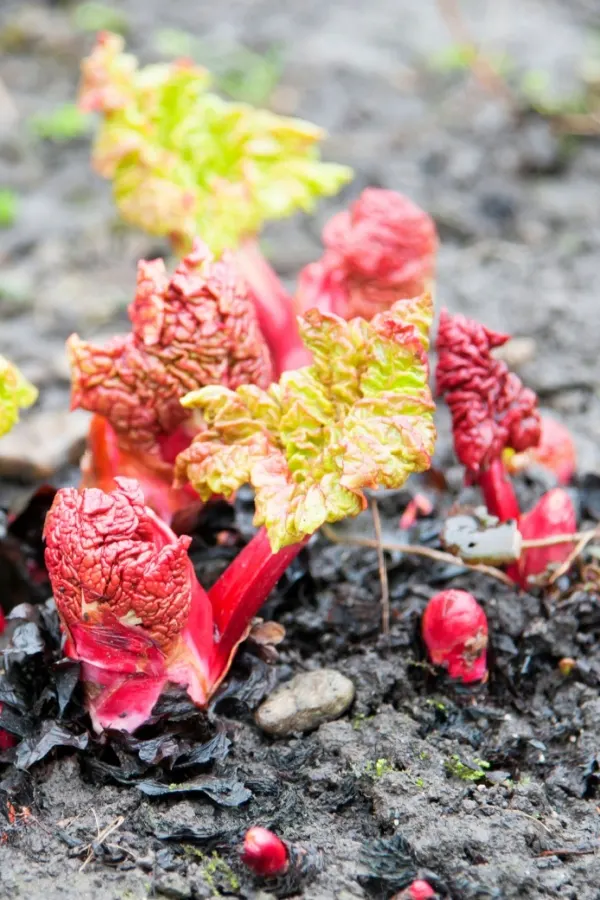
Short & Long Term Care – How To Plant & Grow And Safely Harvest Rhubarb
During the growing season, rhubarb prefers moist but not saturated soil. Crowns will rot if they stay too long in standing water. Plants should receive about an inch of rainfall or hand watering weekly for optimum growth.
Once new growth starts popping up through the soil, add a few inches of organic mulch around the base of the plant. Use a 1 to 2-inch layer of compost first to provide the plant with additional nutrients. Top the compost with shredded leaves, straw, grass clipping, or wood chips.
Here comes the hard part – it’s important not to harvest any stems from your rhubarb in the first year after planting. This helps to establish plants and will result in healthier, stronger plants in the long run. During the second year, only harvest a few stalks.
Once rhubarb is growing for its third season, you can start to harvest in full. Never remove more than half of the plant at one time so it can continue to feed itself. Each plant usually will provide a good harvest for about 8 to 10 weeks.
Choose the largest stems that are around 12 to 18 inches long for harvesting. Depending on your rhubarb variety, they may be red or green in color. Instead of cutting the base of the stalk, pull each stalk and twist. The stalks should easily pull out.
After harvesting, remove the leaf from the stalk and compost or dispose. The stalk can then be cut up and used immediately for baking or cooking. The stalks can also be refrigerated for up to a week or chopped and frozen for later use.
Long Term Care – How To Plant & Grow And Safely Harvest Rhubarb
If you notice flower stalks starting to form on your rhubarb, always remove them immediately. These can occur because of stress or inconsistent watering. The flower stalks will drain energy from the plant if allowed to grow and go to seed.
When plants die back in the fall, remove all the plant debris. However, do not pull or remove the dying growth too early. It’s important to first allow the foliage to die back completely. This allows the roots to store up valuable energy for the following spring.
Each spring, apply a dose of all-natural fertilizer as the ground starts to thaw. Use a balanced fertilizer with a Nitrogen, Phosphorous & Potassium make-up near 10-10-10 to 12-12-12. This is more than sufficient to keep soil powered up. Affiliate Product Link: Espoma 10-10-10 Garden Food
If the stems start to grow spindly and thin, it’s time for dividing. This typically occurs every 5 to 10 years. Wait to divide plants until they are dormant in the late fall or early spring. Cut the roots into sections that are at least 2 inches wide, taking care not to damage any buds. Plant new divisions immediately.
Here’s to enjoying years of amazing harvests from your rhubarb plants! Happy Gardening – Jim and Mary.
Old World Garden Farms
Follow Our Facebook Page For Even More Great Gardening, DIY & Recipe Tips! OWG Facebook Page
Jim and Mary Competti have been writing gardening, DIY and recipe articles and books for over 15 years from their 46 acre Ohio farm. The two are frequent speakers on all things gardening and love to travel in their spare time.
As always, feel free to email us at thefarm@owgarden.com with comments, questions, or to simply say hello! You can sign up for our free email list in the subscribe now box in the middle of this article. Follow us on Facebook here : OWG Facebook. This article may contain affiliate links.

